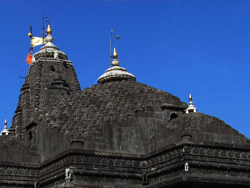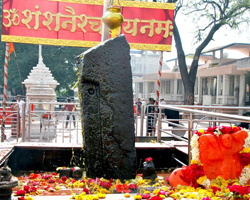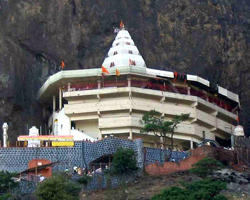
Shirdi -Sai Baba
Sai Baba of Shirdi was a crown jewel among Saints. He lived his entire life out in a small and obscure village in India. The villagers of Shirdi each claimed him as a member of their own religion, Muslim or Hindu, but really he came to make peace between them and he always encouraged each to stick to his own religious path. He drew devotees from all over the country though he never traveled and never cared for fame. Over and over his devotees found he knew their innermost thoughts and details of their lives. He effected cures, conferred health, happiness, and prosperity, and made childless couples conceive.
His real purpose though was to awaken in them a longing for the spiritual life. Thousands thought of him as a wonderful saint with miraculous powers but his innermost circle knew him to be in incarnation of God himself. Some said of Datta, others of Shiva, still others saw ecstatic visions of their own beloved Guru or chosen Ishta (personalized icon of God) while gazing at Him. He himself said only that he was the humble servant of God and pleased and furthered all who came in contact with him. Many books have been written about Shirdi Sai Baba but the Shri Sai Satcharita, the story of Sai Baba's life and actions (quoted from below) was written in his own lifetime and is best known among Sai devotees. Just before leaving his body he told a disciple he would be reborn in a certain village 8 years hence and so it came to pass. (See section on Sathya Sai Baba.)
Sai Baba was first seen as a youth of sixteen sitting under a neem tree in Shirdi. None knew his origin or past. Even then he seemed to be full of the knowledge of Brahman. He had no desire for worldly objects, even in dream. He kicked out Maya (illusion) and Mukti (illumination) was serving at his feet. This young lad, fair, smart, and very handsome, was first seen under a Neem tree seated in an Asan (meditative posture). The people of the village were wonderstruck to see such a young lad practicing hard penance, not minding heat and cold. By day he associated with none. by night he was afraid of nobody. People were wondering whence that young chap turned up. His form and features were so handsome that a mere look endeared him to all. He went to nobody's door, always sat near the Neem tree. Outwardly he looked very young; but by his action He was really a great soul. He was the embodiment of dispassion and an enigma to all.A saint name Gangagir who frequented Shirdi said of him on first setting eyes on him "Blessed is Shirdi, that it got this precious jewel". Another saint by name Anandanath said "This is a precious diamond in reality, though he looks like an ordinary man. You will realize this in the near future."Peace or calm was his ornament and he was the repository of wisdom. He had no love for perishable things and was always engrossed in self-realization. He did not know or care for honor or dishonor. The name of Allah was always on his lips. His inside was as calm as the deep sea. Though he sat in one place, he knew all the transactions of the world. Though a Siddha (realized being), he acted like a sadhaka (disciple on the spiritual path). He was meek, humble, and pleased all.
Shirdi is a town and falls under the jurisdiction of municipal council popularly known as Shirdi Nagar Panchayat, located in Rahata Tahasil (i.e. taluka) in Ahmednagar District in the Indian state of Maharashtra. It is accessible via the Ahmednagar - Manmad State Highway No.10, approximately 83 km from Ahmednagar and 15 km from Kopargaon. It is located 185 km east of the Western Seashore line (the Ahmednagar - Manmad road), which is a very busy route. Shirdi is best known as the late 19th century home of the popular guru Shirdi Sai Baba.Contents
Transportation Shirdi is located approximately 296 km from Mumbai, capital of Maharashtra in India. It is called the Land of Sai. Helicopter services are available to Shirdi. The helipad is owned by Shri Sai Baba Sansthan Trust. One has to take the permission of the trust to land here. Shirdi now has a new railway station called "Sainagar Shirdi", which became operational in March 2009. The project was to be completed in 2001, but was actually completed only in 2009 due to various reasons. The new railway station is located just 2 km from Baba's Temple in Shirdi. The Shirdi Sansthan also provides bus transportation from the train station to their guest houses for those devotees that have chosen to reserve a room and stay at the newly constructed Sansthan guest houses (for most updated information pertaining to this, please see the Shirdi Sai Sansthan website).
As of 2010, there are trains from Chennai (Tamil Nadu), Mumbai (Maharashtra), Vishakhapatnam via Secunderabad (Andhra Pradesh) and other cities/states that have Shirdi railway station as their terminal stop. This means that devotees can get off the train at the Shirdi railway station and reach Baba's Mandir in less than 10 minutes (unlike in earlier years when one had to take a taxi or bus from Manmad and it took over an hour to reach Shirdi). Most trains arriving at Shirdi now have air-conditioned class, first class, second class and third class compartments, thus providing different levels of comfort and convenience according to the needs and affordability of the devotees. Trains also run from Manmad station which is 58 km from the heart of Shirdi, alternatively from Kopargaon station which is 15 km from Shirdi, or Nashik city, which is 119 km from Shirdi or Nagarsol. Daund railway station is 200 km from Shirdi. Buses and taxis ply from these railway stations and locations to and from Shirdi. Shirdi can be reached by bus from any of the following cities in Maharashtra State (India): Mumbai, Pune, Vashi, Panvel, Thane, Nashik, Akluj, Dhule, Nagpur and Aurangabad. Currently, four-laning of State highway Nagar-Manmad highway is in progress on BOT basis and should be completed by Mid-2010. Maharashtra State Road Development Corporation has been assigned to execute the works of internal roads in Shirdi. Soon, Shirdi will have its own airport by 2012. It is to be located at Kakdi (Kopargaon Tahasil), some 14 km towards south-east of Shirdi. Construction work for airport has commenced this year.
Places to visit Shani Shingnapur which is a holy place located near Shirdi, is famous for temple of Lord Shani.Sai Baba Sansthan Trust has started work for a new "Sai Garden" based on the life & teachings of Shri Sai Baba on a 25-acre (100,000 m2) campus at Nimgaon-Korhale near Shirdi. It will provide devotees a glimpse of life of Sai Baba along with laser shows, live shows etc.
Development • Shirdi is getting ready for year 2018, the year of 100th anniversary of Shri Sai Baba Punyatithi. It was on the day of Dassera in 1918 that Shri Sai Baba took Samadhi. State Government along with local municipal council & Shri Sai Baba Sansthan have started planning for the 2018. For this they are making a master plan to handle the crowds & create more facilities for staying, ease of darshan in minimum possible time. These planned development has given a boost to Shirdi's infrastructure & overall development in and around Shirdi. In coming years a new Shirdi Urban Development Authority (SUDA)on basis of MMRDA, is to be formed, which will oversee all these developmental works for Shirdi & surrounding 12 villages. Formation of SUDA will make it possible for an integrated development. Looking at this opportunity an increasing number of hospitality groups are entering Shirdi. Taj Gateway, Holiday Inn, ITC Fortune, St.Laurn are some of the properties becoming operational in coming years. Shri Sai Baba Sansthan is also adding to its rooms for devotees. Currently, it is constructing a 1500 rooms "Sai Ashram" behind its Bhakt Niwas (popularly known as 500 rooms).

Shani-Singnapur ( Shani Dham )
Located at a distance of 65 kms from Shirdi in the Ahmednagar district, the Shani Shingnapur Temple is dedicated to Lord Shaneshwar or Lord Shanidev. He is regarded as the personification of planet Saturn is preached over here. The entire village around the Shani Shingnapur Temple has no doors at their residences. The people residing by the temple have a deep belief in the almighty Lord Shanidev and regard him as their sole protector. The village has not even been reported for theft or robbery till date. The idol of Lord Shanidev is placed inside the Shani Shingnapur Temple and is made up of large black stone. Devotees are allowed to enter the temple premises after taking a bath. Only males are permitted inside the temple. Prayers are offered by the devotees in traditional dhotis at the Shani Shingnapur Temple.
when the Shepherd touched the stone with a pointed rod, the stone started bleeding. The shepherds were astounded. Soon the whole village gathered around to watch the miracle. On that night Lord Shanaishwara appeared in the dream of the most devoted and pious of the shepherds. He told the shepherd that he is "Shanaishwara". He also told that the unique looking black stone is his swayambhu form. The shepherd prayed and asked the lord whether he should construct a temple for him. To this, Lord Shani Mahatma said there is no need for a roof as the whole sky is his roof and he preferred to be under open sky. He asked the shephered to do daily pooja and 'Tailabhisheka' every Saturday without fail. He also promised the whole hamlet will have no fear of dacoits or burglars or thieves.
So, Lord Shanaishwara can be seen even today, in the open yard without any roof above. To this day, there are no doors for any houses, shops, temples. It is to be seen to believe that even post office has no door, not to speak of locks. Due to the fear of Lord Shani, none of the structures, be it dwelling houses, huts, shops, etc. situated within one kilometer radius of this Lord Shani temple have neither doors nor locks. No thievery or burglary was reported until 2010 when first theft was reported and again another one was reported in 2011.Some who have tried to steal have died vomiting blood within minutes of their act and before they could cross the boundary. Many others are said have received varied punishments such as long sickness, mental imbalance etc.
This Shani Shingnapur is visited daily by thousands of devotees praying for Lord Shaneswara's favour. The place is busiest on Saturdays. Shani Trayodasi is considered to be a favorite day for the lord. Similarly Saturday falling on 'Amavasya'(new moon day in Sanskrit and many other Indian languages) is considered to be a favourite day for the Lord Shanaishwara and on that days devotees seeking his blessings throng this temple in thousands.

Saptshrungi Devi ( Vani )
Hindu almanac considers three and half days as highly auspicious. They are Gudipadwa - Hindu's New Year, Dushhera, Diwali and Akshaytritiya. Likewisedwelling places of Goddesses in Maharashtra are famous. Tuljapur where Tulja Bhawani dwells, Kolhapur, the dwelling place of Ambabhavani, and Mahur where Kulaswamini dwells. Saptashringa Garh where Goddess Bhagawati dwells is half as important as any of the earlier mentioned places of Goddesses in Maharashtra. Saptashringa means the mountain having seven peaks. It is around 55 kms away from Nashik. Nanduri village is situated at the foot of the Saptashringa Garh.
The road to the temple is zig - zag and climbs around 11 kms till it reaches the top. In front of the temple there stands Markandeya Rishi's (sage) hill. The Saptashringa Garh is full of a variety of trees having medicinal worth. As per the story in the epic Ramayana, Hanuman carried the herbal medicine for wounded Laxmana from this hill. There are about 108 water reservoirs on the hill. They are called as Kundas..
when the Shepherd touched the stone with a pointed rod, the stone started bleeding. The shepherds were astounded. Soon the whole village gathered around to watch the miracle. On that night Lord Shanaishwara appeared in the dream of the most devoted and pious of the shepherds. He told the shepherd that he is "Shanaishwara". He also told that the unique looking black stone is his swayambhu form. The shepherd prayed and asked the lord whether he should construct a temple for him. To this, Lord Shani Mahatma said there is no need for a roof as the whole sky is his roof and he preferred to be under open sky. He asked the shephered to do daily pooja and 'Tailabhisheka' every Saturday without fail. He also promised the whole hamlet will have no fear of dacoits or burglars or thieves.
Idol of Goddess
Saptashringi Goddess is known as Khandesh's Goddess. Devotees from Chalisgaon, Jalgaon, Malegaon and Dhulia visit this temple frequently. The idol of the Goddess is set at a height, so that she can be seen from a distance too. She has 9 pairs of arms, holding different weapons. Her sparkling eyes, slightly inflated nostrils wearing Nath (an ornament to be worn in the nose) and 18 hands look very attractive.Every full moon day and during Navaratri the temple is crowded with devotees. The Goddess is offered coconuts and sarees. The Goddess is also called as Mahishasur Mardini. A story in this connection is that Demon Mahishasur was creating problem for Markendaya Rishi. Markendaya had made a Holy Fire to eliminate him. The Goddess emerged with 9 pairs of arms holding different weapons from theoly Fire and eliminated the Demon. Hence Mahishasur Mardini, meaning the one who slayed Mahishasur.
Facilities
Of late, this place has been renovated. Railings on the road side have been constructed. The staircasehas been covered to protect devotees from sun and rain. Two separate routes for going up and coming down are built. To take rest while climbing the 470 steps, benches at certain intervals have been placed.For a night's halt, Dharmashala (caravansaray) is arranged by the Trustees. They make blankets and mattresses available to the visitors. Maharashtra Tourism Development Corporation has built rest housesthere. Literature about the Goddess , photos, coconuts and saries for offering to the Goddess areavailable. Priests help tourists to perform Puja. Low cost but clean food is also available in the Priest's houses.
Sheetakada
As you go a little further from the temple there is a peak called Sheetkada and a deep valley. It is approximately 1500 feet deep. An anecdote attached to this place goes like this. A lady prayed and urged Goddess Bhagawati to give her a son. If her wish was fulfilled by the Goddess, as a gesture of gratitude, she offered to jump in the valley, sitting in a bullock-cart. It is said that since she got a son, the lady kept her promise and did jump along with her son sitting in a bullock-cart in the valley. The marks of bullock-cart are still visible on the Sheetkada. The Sheetakada is at the height of approximately 4638feet from the sea level. The Goddess Bhagawati is also called as Wani Goddess. On reaching the top of the hill, one still has to climb 470 steps to reach the temple. Old records show that these steps were built by Umabai Dabhade in 1710.
Significance of the Flag
The Holy Flag of Goddess Bhagawati flutters in the north of Saptashringa Garh. hoisting of the Flag is a privilege of a particular family. The ritual of Flag hoisting on a specific day is witnessed by thousands ofdevotees. People believe that the Goddess fulfills their wishes. So this place is frequented by devotees throughout the year.



